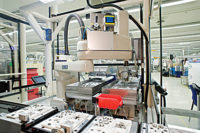Tervis introduced its cup-within-a-cup design in 1946. In 2010, the company enjoyed a 60 percent increase in sales, added over 200 jobs, and boosted manufacturing space by 35,000 square feet. Today, the company is a three-shift operation employing more than 600 people and assembling tens of thousands of cups daily.
There’s no premade inventory at Tervis. Each tumbler is assembled to order. The company produces tumblers in six sizes, ranging from 8 to 24 ounces. Consumers can customize their tumblers with accessories, such as handles and lids, and hundreds of decorative designs, including team insignias, corporate logos and cartoon characters.
The tumblers are assembled in robotic workcells designed and built by RND Automation & Engineering of Sarasota, FL. RND built an alpha cell with one robot and one ultrasonic welder for Tervis a year ago. The project was so successful that Tervis ordered four additional, second-generation cells.
The assembly process begins with a low-profile indexing conveyor from Dorner Manufacturing Corp. The conveyor is fitted with plastic pucks to transport the inner and outer portions of the tumbler. After passing beneath a deionized air blast and vacuum station to remove dust, the tumbler halves are conveyed to the decorator station.
An operator decorates the inner portion of the outer tumbler with a custom adhesive patch or decal and places it in the corresponding puck next to the inner tumbler. To prevent mix-ups, sensors ensure that the inner and outer tumblers match in size, explains Sean Dotson, PE, president of RND.
Next, the inner and outer tumblers index into the cell, where a vertically mounted linear slide from IAI America Inc. picks up the inner tumbler using a unique inflatable gripper from Firestone Industrial Products. The gripper is essentially a heavy-duty rubber balloon. The balloon is inserted inside the tumbler and inflated. Pressure from the balloon against the inside walls of the tumbler provides sufficient force to grip and remove the part from the puck.
When the conveyor indexes again, the slide inserts the inner tumbler into the outer one, aligning several key features in the bottoms of the parts. After one more index, the assembled, but unwelded tumbler is presented to a SCARA robot from EPSON Robots.
The robot is equipped with a gripper from SCHUNK Inc. that can manipulate two tumblers at one time. After picking up an unwelded tumbler from the conveyor, the robot picks up a welded tumbler from the ultrasonic welder. The robot then spins the gripper 180 degrees and delivers the unwelded tumbler to the welder, which was supplied by Dukane Ultrasonics. The robot then drops off the welded tumbler onto an indexing out-feed conveyor, where an operator puts it into a bag, gift box or bulk container.
The cell can assemble tumblers in lots of one or 10,000, says Dotson. It can run both 16- and 24-ounce tumblers on the fly. Sensors determine the size of the tumbler, and the cell automatically adjusts the motion of the linear actuator, robot, welder and blow-off station. “Everything about the cell was ‘engineered to order,’” he adds.
“RND has been chosen for past projects because of their relationship-building and the integrity of not giving us what we want, but...what we need,” says Paulo Reis, director of operations at Tervis. “Some end users have a concept in their minds, but RND takes that concept through their engineering experience and produces a highly thought-out system.”
After assembly, engineers periodically test a few tumblers to ensure they are leak-free. A vision system is also used to verify the integrity of the weld.
For more information on assembly systems, call RND Automation at 941-870-5400 or visit www.rndautomation.com.
Editor’s note: Whether you’re a systems integrator or the in-house automation team of an OEM, if you’ve designed a system that you’re particularly proud of, tell us about it. Send an e-mail to John Sprovieri, editor in chief of ASSEMBLY, at sprovierij@bnpmedia.com, or call 847-405-4068.


